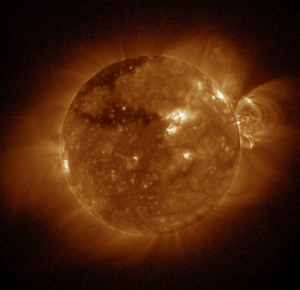Solar and Heliospheric Physics
The sun is the closest star to us and the source of all life on earth. The sun is also a special star in astrophysics because it is the only star that is close enough for us to spatially resolve surface details. Charged particles flow continuously from the Sun into space and form the so-called "solar wind". The solar wind determines the structure of our heliosphere that surrounds our sun and extends to the outer planets.
Occasionally, the continuous solar wind is interrupted by huge ejections of magnetized solar matter, so-called "coronal mass ejections". Coronal mass ejections and their associated high-energy radiation bursts (“flares”) from the Sun are the most energetic events in our solar system and can cause strong disturbances of the "space weather" near Earth. The physical trigger for all these energetic phenomena is the Sun's magnetic field, especially the strong field in sunspots.

Research topics
The Physics of the Sun and the Heliosphere working group at the University of Graz conducts research on the following topics, among others:
Flares and coronal mass ejections (CMEs) are the most energetic events in our solar system. CMEs are magnetized plasma clouds that are ejected from the Sun at speeds of hundreds to thousands of kilometers per second, disrupting the coronal magnetic structure and the steady flow of solar wind. Flares are a sudden localized enhancements of the solar radiation caused by impulsively heated plasma and accelerated particles. The occurrence frequency of flares and CMEs vary with the 11-year activity cycle of our Sun. We study the energy release processes in solar flares and CMEs, the underlying magnetic instabilities, the acceleration of high energy particles and their interaction with the solar atmosphere. We use data from various ESA and NASA satellites, like Solar Orbiter, Parker Solar Probe, Solar Dynamics Observatory, STEREO as well as our own observation from Kanzelhöhe Observatory for Solar and Environmental Research.
Coronal mass ejections (CMEs) are huge clouds of magnetized plasma that are ejected from the outermost layer of the Sun at speeds ranging from a few hundred to 3000 kilometers per second. The fastest CMEs can reach Earth in less than a day after being ejected from the Sun and can cause severe geomagnetic storms when they hit the Earth's magnetosphere. We are working to better understand the expansion and propagation of CMEs through the space between planets in the inner heliosphere in order to better predict the arrival of CMEs and their impact on Earth's atmosphere. This knowledge is crucial as strong CMEs are the main cause of severe space weather disturbances on Earth, jeopardizing our modern technological infrastructure, especially satellites in Earth orbit and power grids on the ground.